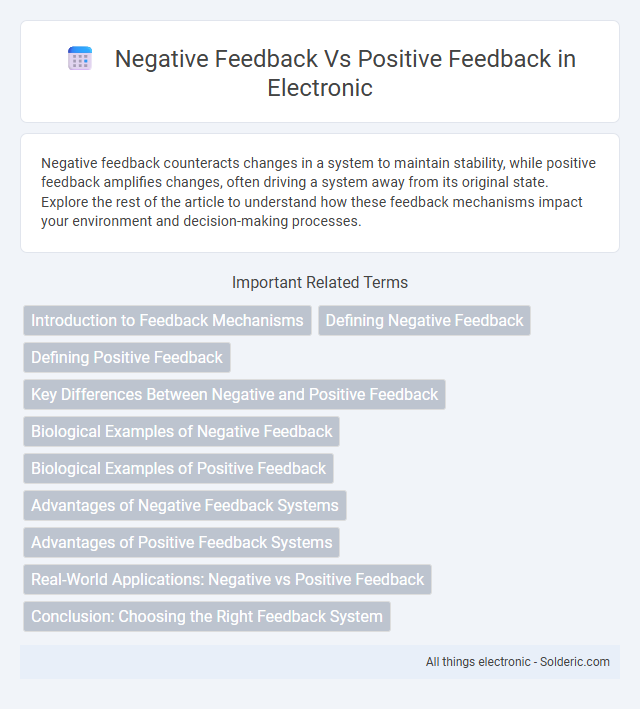Negative feedback counteracts changes in a system to maintain stability, while positive feedback amplifies changes, often driving a system away from its original state. Explore the rest of the article to understand how these feedback mechanisms impact your environment and decision-making processes.
Comparison Table
| Aspect | Negative Feedback | Positive Feedback |
|---|---|---|
| Purpose | Corrects errors or undesirable behavior | Reinforces desired behavior or outcomes |
| Effect | Reduces deviation or stops unwanted actions | Increases motivation and strengthens performance |
| Use in Control Systems | Stabilizes system by counteracting change | Amplifies system response, can lead to instability |
| Example | Thermostat lowering temperature when too high | Positive reviews encouraging repeated behavior |
| Outcome | Maintains equilibrium or set point | Promotes growth or escalation |
Introduction to Feedback Mechanisms
Feedback mechanisms regulate biological systems by maintaining homeostasis through negative feedback, which reduces deviations from set points by counteracting changes. Positive feedback amplifies responses, driving processes to completion such as blood clotting and childbirth. Understanding these mechanisms is crucial for grasping physiological regulation and stability in organisms.
Defining Negative Feedback
Negative feedback is a regulatory mechanism where the output of a system inhibits or reduces its own activity to maintain stability and homeostasis. It plays a crucial role in biological systems like hormone regulation, where increased levels trigger responses that decrease further production. This process contrasts with positive feedback, which amplifies deviations rather than correcting them.
Defining Positive Feedback
Positive feedback amplifies changes or deviations in a system, leading to an exponential increase or acceleration of the initial effect. It reinforces the direction of the disturbance, often resulting in a self-perpetuating cycle that drives system behavior away from equilibrium. Common examples include blood clotting and childbirth contractions, where the response intensifies until a specific outcome is achieved.
Key Differences Between Negative and Positive Feedback
Negative feedback reduces deviations by counteracting changes, maintaining system stability, while positive feedback amplifies changes, driving systems toward a new state or output. In biological systems, negative feedback regulates hormone levels to keep balance, whereas positive feedback speeds up processes like blood clotting. Understanding these key differences helps you effectively apply feedback mechanisms in control systems or personal development.
Biological Examples of Negative Feedback
Biological examples of negative feedback include the regulation of body temperature, where the hypothalamus detects changes and triggers responses like sweating or shivering to maintain homeostasis. Blood glucose levels are controlled by insulin and glucagon hormones, which lower or raise glucose concentration to keep it within a healthy range. Your body's ability to use negative feedback systems ensures stability by correcting deviations from set points.
Biological Examples of Positive Feedback
Positive feedback in biological systems amplifies responses to stimuli, as seen in blood clotting where platelets release chemicals that attract more platelets to the injury site, accelerating the clot formation. During childbirth, the release of oxytocin intensifies uterine contractions, further stimulating more oxytocin production until delivery occurs. These mechanisms enhance and expedite vital processes, highlighting how your body uses positive feedback loops to maintain essential functions.
Advantages of Negative Feedback Systems
Negative feedback systems improve stability and accuracy by automatically correcting deviations from a desired setpoint, reducing error and preventing system oscillations. These systems enhance performance in electronic amplifiers, control engineering, and biological processes by maintaining consistent output despite external disturbances. Their ability to promote system equilibrium ensures reliable and predictable operation in complex environments.
Advantages of Positive Feedback Systems
Positive feedback systems amplify changes, driving processes toward completion and enabling rapid responses, such as blood clotting or childbirth contractions. These systems reinforce and accelerate beneficial outcomes, ensuring swift adaptation and decisive actions. Your understanding of positive feedback highlights its critical role in biological and technological regulation.
Real-World Applications: Negative vs Positive Feedback
Negative feedback regulates systems by reducing deviations from a set point, crucial in applications like home thermostats and blood glucose control to maintain stability. Positive feedback amplifies changes, driving processes such as blood clotting and childbirth contractions to completion. Your understanding of these feedback mechanisms helps optimize control systems in engineering, biology, and electronics for reliable and efficient performance.
Conclusion: Choosing the Right Feedback System
Selecting the appropriate feedback system depends on the desired outcome: negative feedback stabilizes systems by reducing deviations and promoting consistency, while positive feedback amplifies changes, driving rapid growth or transformation. In engineering and biological systems, negative feedback is preferred for maintaining equilibrium, whereas positive feedback is ideal for triggering processes like childbirth or nerve signal transmission. Understanding the context and goals ensures effective implementation of feedback mechanisms for optimal system performance.
negative feedback vs positive feedback Infographic

 solderic.com
solderic.com